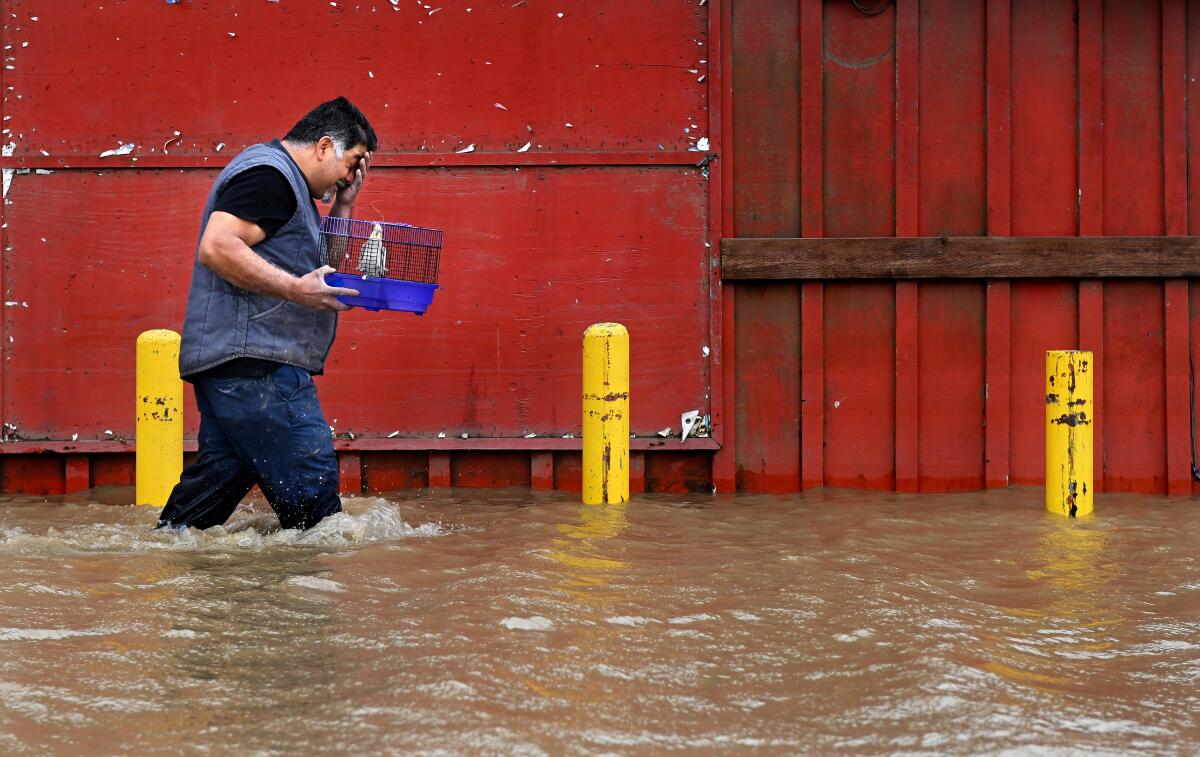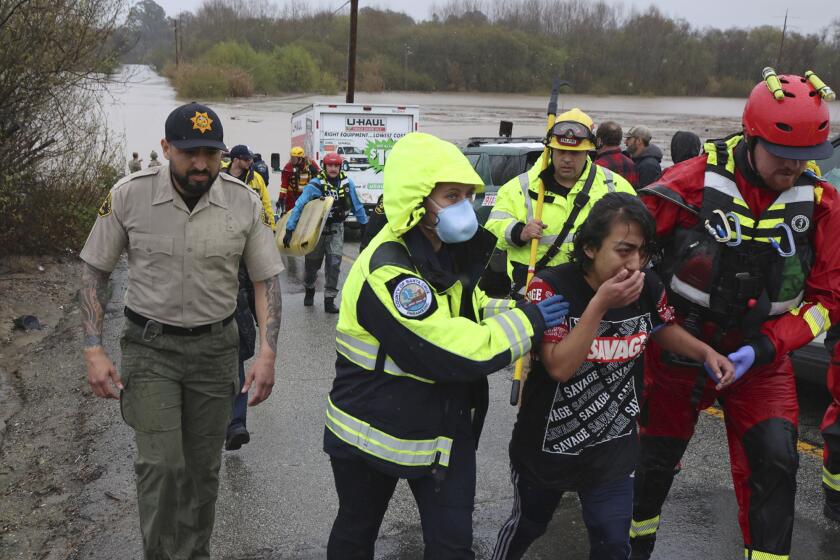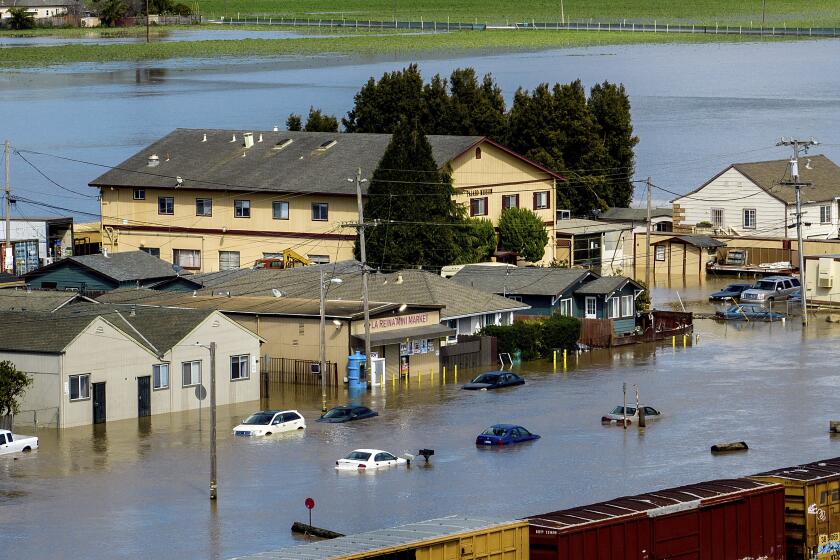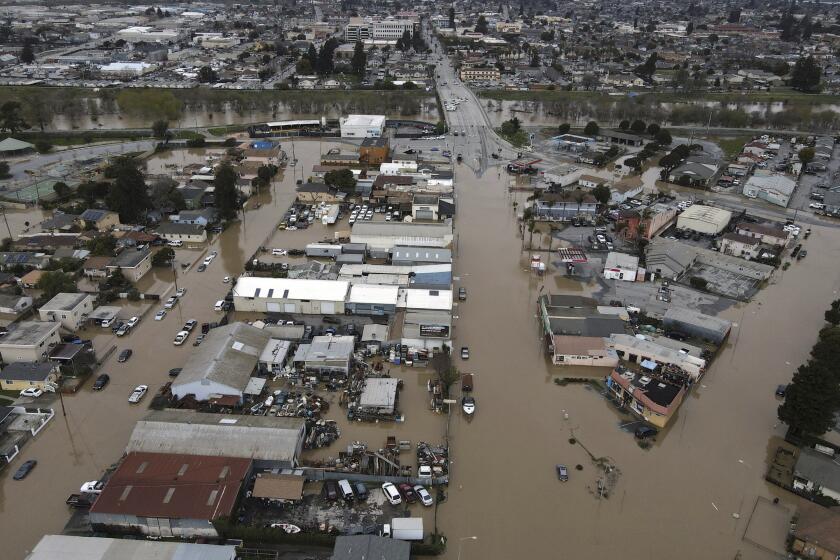Why is Pajaro not deemed a FEMA disaster after massive flooding from California storms?

- Share via
It’s been nearly two weeks since a levee breached on the Pajaro River, flooding the nearby unincorporated community of Pajaro and sending its roughly 3,000 residents into what county officials suggest could be a months-long exile.
Despite promises from Gov. Gavin Newsom that a request for federal aid was forthcoming, no such entreaty has been made.
At a news conference last week in Pajaro, Newsom recounted phoning President Biden soon after the crisis. According to the governor, the president said: “As soon as you get that assessment in, let me know.”
“We have all the confidence he’ll be there for us,” Newsom told the crowd.
However, unless officials can broaden the scope of the disaster — maybe to include counties such as Tulare and Kings, which have experienced widespread flooding — such a request by Newsom is growing increasingly unlikely, according to a spokesman for the Governor’s Office of Emergency Services.
The Federal Emergency Management Agency “has a pretty complex criteria in terms of what” a disaster is ... “and what the standards are,” said Brian Ferguson, director of crisis communications for the emergency services office.
So far, he said, Pajaro doesn’t qualify.
“To give you a general ballpark,” he said, “it typically means 1,200 homes must have been either severely damaged or destroyed.”
A levee failure on the Pajaro River in Monterey County triggered massive flooding and prompted hundreds of evacuations and dozens of water rescues.
George Nunez, division chief of the California Department of Forestry and Fire Protection, said only 903 buildings in Pajaro have been damaged — and of those, only six are so bad they can’t be entered.
It’s a blow to a community that has long been marginalized and neglected.
On Thursday afternoon, residents were allowed to enter the town for the first time since the flooding to check on their homes and belongings.
Earlier this month, a federal official told The Times that government engineers had known for years the levee protecting the town could fail. The official admitted an improvement project never penciled out, in part, because “it’s a low-income area. It’s largely farmworkers that live” there.
Residents and business owners are growing increasingly frustrated at the government’s response.
Anali Cortez, 17, who has been sharing a hotel room with her parents, three brothers and two sisters after they were unable to get into a shelter, said she’s frustrated by the lack of assistance her family has received.
She said county officials have said to wait as they work to get FEMA on the ground.
“They keep saying, ‘Wait, wait,’ but what are we waiting for?” she said in a phone interview.
The migrant town of Pajaro, Calif., was flooded last week during powerful storms that caused a levee to break. Now, another storm is moving in.
The teen said her family has applied for financial assistance through a nonprofit and the county is providing some funding, but so far, they have gotten no response.
She said most residents know the county is trying to help, but it seems those efforts are not well-executed. Take, for example, the portable bathrooms placed in a nearby park.
“Do I really need to walk to the park to use the bathroom?” she said, adding that the county should have dispersed the restrooms throughout the community.
Upon learning that Pajaro doesn’t yet meet the criteria for FEMA assistance, the girl said: “I don’t think that’s right.”
“Just because it didn’t reach the level of destruction that they want doesn’t mean we can’t get any help. Everyone has been affected by the disaster no matter what.”
She and others pointed to the quick response their wealthy neighbors received after the January storms.
Nine days after a storm battered the Santa Cruz coastline — toppling iconic restaurants and bars along the Capitola waterfront and crumbling the cliff below Santa Cruz’s West Cliff Drive — Biden declared the region a major disaster.
“We’ve got tens and tens of millions of dollars of damages out here, so I’m not quite sure” how the community couldn’t qualify, said Glenn Church, a Monterey County supervisor whose district encompasses Pajaro.
A FEMA major disaster declaration provides direct aid to individuals and businesses that suffered losses as a result of storm damage and flooding. In order to get such a declaration, the governor must request it directly from the president.
Typically, such requests are supported with damage estimates — preliminary assessments that outline the damage and indicate the need for federal assistance.
In the case of the January storms, Ferguson said, the damage was so widespread it was easy to “quickly add up to the totals” they needed.
But in Pajaro’s case, because the damage is so localized, it’s taking longer.
“We could be counting for several weeks and may or may not ultimately get there,” he said, adding that the governor’s office is doing everything it can to be “creative” to secure funding — whether through FEMA or other federal and state programs.
He said the nice thing about the FEMA money is that it provides direct financial assistance to individuals and businesses. Most other programs consist of loans.
The concern with sending a request that doesn’t meet FEMA’s disaster thresholds, he said, is that while the federal government deliberates — which could take weeks or months — other avenues of financial support are unavailable.
“Small Business Administration loans are not as good as direct federal assistance ... but loans being available is better than nothing being available,” Ferguson said.
Earlier this month, Newsom secured a more limited Presidential Emergency Declaration, which authorized federal assistance to support storm response and recovery efforts.
Meanwhile, state and local lawmakers are pleading with the governor to fast-track the assessment and request for major disaster relief.
“We need FEMA on the ground here as soon as possible,” said Monterey County Board Supervisor Luis Alejo. “Pajaro residents have been asking, ‘Where are the FEMA workers to help us?’ There is a lot of urgency. ... That federal assistance must be deployed now.”
On March 20, a group of seven state lawmakers — including Sen. John Laird and Assemblymember Robert Rivas — sent a letter to Newsom urging him “to act swiftly to address the many unmet, immediate needs of displaced residents, including Pajaro Valley farmworkers” and “request the major Presidential Disaster Declaration for the most recent series of storms to begin on February 24, 2023.”
Images from space show the hard-hit California towns of Pajaro and Porterville before and after flooding caused by recent storms.
For now, evacuees are largely relying on philanthropic funds and donations to provide assistance, said Ray Cancino, CEO at Community Bridges, an Aptos-based organization helping to coordinate aid for displaced Pajaro residents.
Minutes after Monterey County lifted the evacuation orders in Pajaro, allowing residents to return to their community and assess the damage of their homes, Sister Rosa Dolores, founder of Casa De La Cultural Center, got in her car and began driving to Pajaro.
“I’m on my way to check on the center,” she said over the phone.
Dolores has been baffled by the glacial pace at which assistance has been flowing to residents of Pajaro and other surrounding agricultural communities.
She recalled the 1995 flood that led to a FEMA response in which they produced temporary trailers for residents.
“They were there pretty fast and people stayed in them for a year or so,” she said recalling. “It became like a little neighborhood.”
But now, she questions why that federal response was not happening this time around. “If FEMA wants to help us, they need to be in Pajaro now,” she said.
Many of the evacuees Dolores works with are farmworkers who are now unable to work as fields are flooded and crops are damaged.
Companies such as Driscoll’s berries are providing funding to organizations such as Community Bridges.
Ferguson said the fact that Pajaro has a history of marginalization may help with a disaster request.
“In some ways, these communities are more resilient, because for a long time they have not received the support that they needed from their governments and tend to bounce back quicker,” he said. “Because they just by their nature have had to be able to live on their own.”
More to Read
Sign up for Essential California
The most important California stories and recommendations in your inbox every morning.
You may occasionally receive promotional content from the Los Angeles Times.


















